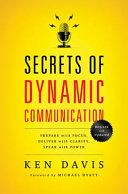

Dynamic communication begins with a deep understanding of your audience. This involves not just knowing who they are, but also understanding their needs, preferences, and expectations. By tailoring your message to resonate with your audience, you can create a connection that fosters engagement and interest. Techniques such as audience analysis, empathy mapping, and feedback loops are essential tools for identifying what your audience values. The book emphasizes that effective communication is not a one-size-fits-all approach; rather, it is a dynamic process that requires continuous adaptation and refinement based on audience responses.
Continue readingThe ability to craft compelling messages is a cornerstone of dynamic communication. This involves structuring your content in a way that captures attention and maintains interest. The book discusses various techniques for message development, including storytelling, the use of metaphors, and the importance of clarity and conciseness. By employing these techniques, communicators can transform complex information into relatable narratives that resonate with their audience. The focus on storytelling highlights the emotional aspect of communication, as stories can evoke feelings and create a lasting impact.
Continue readingNon-verbal communication plays a crucial role in how messages are received and interpreted. The book explores the various elements of non-verbal cues, such as body language, facial expressions, and tone of voice. Understanding how to leverage these non-verbal signals can significantly enhance the effectiveness of your communication. For instance, maintaining eye contact can foster trust and engagement, while an open posture can convey confidence. The author stresses that being aware of your own non-verbal signals, as well as those of your audience, can lead to more meaningful interactions.
Continue readingEvery individual has a unique communication style, influenced by their personality, background, and experiences. The book emphasizes the importance of recognizing and adapting to these different styles to ensure effective communication. By identifying whether someone is more analytical, expressive, or assertive, you can adjust your approach to better align with their preferences. The author provides practical strategies for adapting your communication style, such as using specific language, adjusting your tone, and being mindful of pacing. This adaptability can lead to stronger connections and more productive conversations.
Continue readingActive listening is a vital skill in dynamic communication. It goes beyond merely hearing what someone says; it involves fully engaging with the speaker, understanding their message, and responding thoughtfully. The book outlines techniques for improving active listening, such as summarizing what has been said, asking clarifying questions, and providing feedback. By practicing active listening, communicators can demonstrate respect and validation for the speaker's perspective, which fosters trust and collaboration. This skill is particularly important in conflict resolution and negotiations, where understanding differing viewpoints is essential.
Continue readingIn today's digital age, technology plays a significant role in communication. The book discusses various tools and platforms that can enhance communication effectiveness, such as video conferencing, social media, and collaborative software. However, the author cautions against over-reliance on technology, emphasizing that it should complement, not replace, face-to-face interactions. Strategies for using technology effectively include being mindful of the medium chosen, ensuring clarity in digital messages, and maintaining a human touch even in virtual communications. Understanding the strengths and limitations of each medium can help communicators choose the best approach for their audience.
Continue readingDynamic communication is an ongoing process that requires continual improvement. The book stresses the importance of seeking feedback from your audience and using it to refine your communication strategies. This can involve formal methods, such as surveys and evaluations, or informal approaches, such as casual conversations. By being open to feedback, communicators can identify areas for growth and make necessary adjustments to enhance their effectiveness. The author encourages a mindset of lifelong learning, where individuals actively seek opportunities to develop their communication skills and adapt to changing contexts.
Continue reading